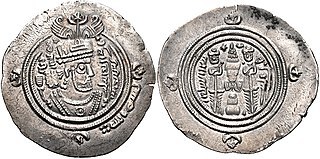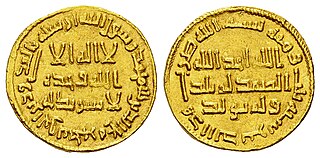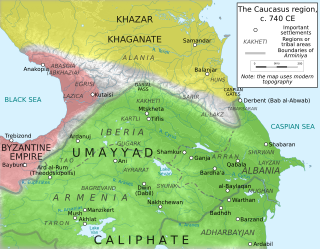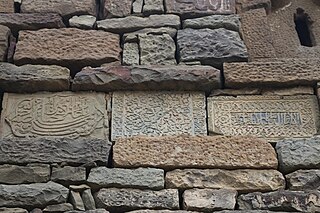
Yazid ibn Mu'awiya ibn Abi Sufyan, commonly known as Yazid I, was the second caliph of the Umayyad Caliphate. He ruled from April 680 until his death in November 683. His appointment was the first hereditary succession to the caliphate in Islamic history. His caliphate was marked by the death of Muhammad's grandson Husayn ibn Ali and the start of the crisis known as the Second Fitna.

Yazid ibn Abd al-Malik, also referred to as Yazid II, was the ninth Umayyad caliph, ruling from 9 February 720 until his death in 724.

Hisham ibn Abd al-Malik was the tenth Umayyad caliph, ruling from 724 until his death in 743.

ʿAbd Allāh ibn Jaʿfar, was a companion and relative of the Islamic prophet Muhammad, a nephew of Ali and a half-brother of Muhammad ibn Abi Bakr. He was loyal to Ahl al-Bayt in spite of his absence at the Battle of Karbala. He is reported to have said: ”Thanks to God Almighty, I could not support al-Husayn ibn Ali at Karbala, but my two sons did." According to Richard Francis Burton he is widely recognized as the most sympathetic amongst Arabs. His grave is situated near Aqil ibn Abi Talib and Abu Sufyan ibn al-Harith in Jannat al-Baqi
Maslama ibn Abd al-Malik was an Umayyad prince and one of the most prominent Arab generals of the early decades of the 8th century, leading several campaigns against the Byzantine Empire and the Khazar Khaganate. He achieved great fame especially for leading the second and last Arab siege of the Byzantine capital Constantinople.
Abu Uqba al-Jarrah ibn Abdallah al-Hakami was an Arab nobleman and general of the Hakami tribe. During the course of the early 8th century, he was at various times governor of Basra, Sistan and Khurasan, Armenia and Adharbayjan. A legendary warrior already during his lifetime, he is best known for his campaigns against the Khazars on the Caucasus front, culminating in his death in the Battle of Marj Ardabil in 730.
ʾAḥmad ibn Yaḥyā ibn Jabir al-Balādhurī was a 9th-century Muslim historian. One of the eminent Middle Eastern historians of his age, he spent most of his life in Baghdad and enjoyed great influence at the court of the caliph al-Mutawakkil. He travelled in Syria and Iraq, compiling information for his major works.
Abū Muḥammad Aḥmad ibn Aʿtham al-Kūfī al-Kindī was a 9th-century Arab Muslim historian, poet and preacher (qāṣṣ) active in the late 8th and early 9th centuries. He was a Shīʿī of the akhbārī school, a son of a student of the sixth imam, Jaʿfar al-Ṣādiq, who died in 765.

The Arab–Khazar wars were a series of conflicts fought between the armies of the Khazar Khaganate and the Rashidun, Umayyad, and Abbasid caliphates and their respective vassals. Historians usually distinguish two major periods of conflict, the First Arab–Khazar War and Second Arab–Khazar War, but the Arab–Khazar military confrontation also involved sporadic raids and isolated clashes from the middle of the 7th century to the end of the 8th century.

The Caspian expeditions of the Rus' were military raids undertaken by the Rus' between 864 and 1041 on the Caspian Sea shores, of what are nowadays Iran, Dagestan, and Azerbaijan. Initially, the Rus' appeared in Serkland in the 9th century traveling as merchants along the Volga trade route, selling furs, honey, and slaves. The first small-scale Viking raids took place in the late 9th and early 10th century. The Rus' undertook the first large-scale expedition in 913; having arrived on 500 ships, they pillaged in the Gorgan region, in the territory of present-day Iran, and more to the west, in Gilan and Mazandaran, taking slaves and goods. On their return, the northern raiders were attacked and defeated by the Khazars in the Volga Delta, and those who escaped were killed by the local tribes on the middle Volga.

The Battle of Hira was fought between the Sasanian Empire and the Rashidun Caliphate in 633. It was one of the early battles of the Muslim conquest of Persia, and the loss of the frontier city on the Euphrates River opened the way to the Sasanian capital at Ctesiphon on the Tigris River.
Lut ibn Yahya ibn Sa'id ibn Mikhnaf al-Azdi, more commonly known by his kunya (epithet) Abu Mikhnaf was a classical Muslim historian based in Kufa.
Khālid ibn Yazīd, c. 668–704 or 709, was an Umayyad prince and purported alchemist.

Al-Hurr ibn Yazid ibn Najiyah Al-Tamimi Al-Yarbuʿi Ar-Riyahi was the general of the Umayyad army dispatched from Kufa, Iraq to intercept al-Husayn ibn Ali ibn Abu Talib. The newly appointed governor of Kufa, Ubayd Allah ibn Ziyad, issued the command to guard all entrances and exits to Kufa in order to intercept al-Husayn for an oath of allegiance to Yazid ibn Mu'awiya ibn Abu Sufyan of the Umayyad dynasty. Al-Hurr ibn Yazid al-Tamimi al-Yarbu'i was to guard one of the roads with his 1,000 soldiers to sanction al-Husayn and his followers and bring them to Ibn Ziyad. Initially responsible for holding al-Husayn and his followers captive, al-Hurr died fighting on al-Husayn's behalf after decisions fueled by corrupt intentions surfaced from Ubayd Allah ibn Ziyad. Al-Hurr's short but provocative mark on history spans less than one week's time, but is embedded with complex details and fatal turns of events that led to the martyrdom of al-Husayn during the Battle of Karbala.

Historically, Dagestan consisted of a federation of mountainous principalities in the eastern part of the North Caucasus. Located at the crossroads of world civilizations of north and south, Dagestan was the scene of clashes of interests of many states and until the early 19th century most notably that of between Persian Empire (Iran) and Imperial Russia.
Yazid ibn Asid ibn Zafir al-Sulami or Yazid ibn Usayd ibn Zafir al-Sulami was an Arab general and governor in the service of the early Abbasid Caliphate. He was active mostly in the Caliphate's northwestern frontier region, serving as governor of Arminiya and the Jazira and fighting against the Byzantine Empire and the Khazars.
Sa'id ibn Amr al-Harashi was a prominent general and governor of the Umayyad Caliphate, who played an important role in the Arab–Khazar wars.
Abū 'Ubayd ibn Mas'ūd ibn 'Amr ibn 'Umayr ibn 'Awf ibn Uqda ibn Ghayra ibn Awf ibn Thaqif al-Thaqafi, or simply Abu Ubayd, was a commander in the army of the Rashidun Caliphate. He was from Ta'if in western Arabia, and belonged to the tribe Banu Thaqif.
In the history of Azerbaijan, the Early Middle Ages lasted from the 3rd to the 11th century. This period in the territories of today's Azerbaijan Republic began with the incorporation of these territories into the Sasanian Persian Empire in the 3rd century AD. Feudalism took shape in Azerbaijan in the Early Middle Ages. The territories of Caucasian Albania became an arena of wars between the Byzantine Empire and the Sassanid Empire. After the Sassanid Empire was felled by the Arab Caliphate, Albania also weakened and was overthrown in 705 AD by the Abbasid Caliphate under the name of Arran. As the control of the Arab Caliphate over the Caucasus region weakened, independent states began to emerge in the territory of Azerbaijan.